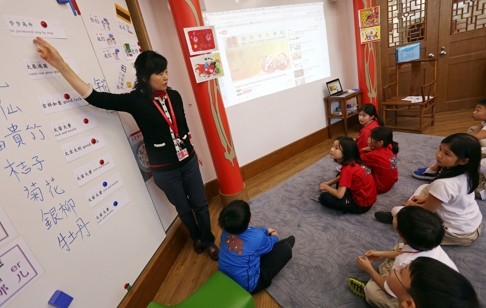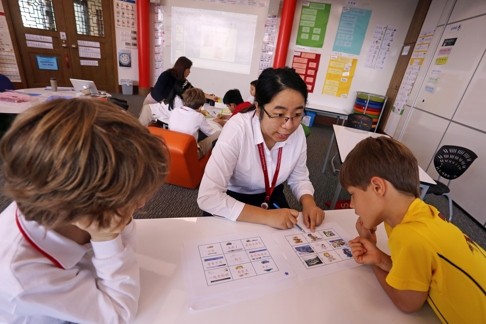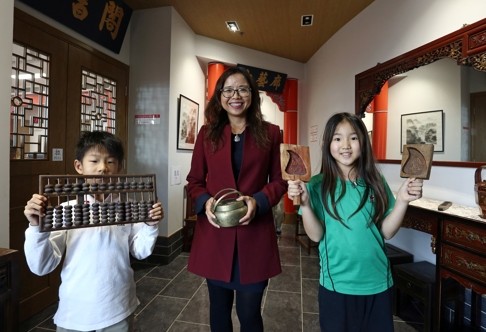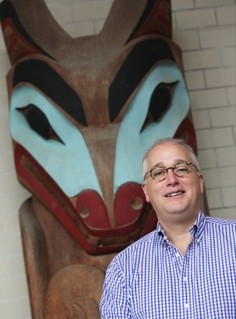
Not just a language: international school in Hong Kong stresses Chinese culture
Canadian International School shows how serious it is about making sure students get China by investing HK$60 million on new wing intended as a space where they can learn about Chinese arts, music, and history after lessons.

About half of the students enrolled at the Canadian International School are ethnic Chinese, but that’s not why it invested HK$60 million to build a new wing dedicated to learning about Chinese culture. The idea is to help students navigate a world in which China is the lodestone.
Opened in January, the school’s Chinese Cultural Centre provides an immersive environment for such learning: Its four classrooms are shaped like the Taoist bagua symbol; even the corridors are decorated with traditional Chinese kitchen utensils and inventions such as the abacus.
Although Chinese-language lessons for junior forms are held in the centre, the main aim is to create a space where students can learn about Chinese culture after school, says Penny Pan, the school’s director of Chinese studies.
“The Chinese orchestra of 34 students playing erhu, zither, pipa and flute perform there. There are also Chinese painting classes, a dance club and choir. Later we will have martial arts classes.”
Shadow puppet and paper cutting masters will also be brought in for the school’s artist-in-residence programme, which previously introduced martial arts troupes and dragon dance masters, Pan says.
Chinese is a compulsory subject up to Grade Eight at the Canadian International School, where students have seven lessons each week – two more than the usual five periods at other international schools. At Grade Nine, they may opt to study French instead but 95 per cent of students choose Chinese.

The rest enter the non-native stream, in which students learn Chinese as an additional language and study simplified Chinese characters.
“Non-native kids go to universities in the UK or America. Most of those universities [use] simplified Chinese characters these days. Most native Hong Kong kids go to local universities which use traditional Chinese characters,” Pan explains.
In the past, Chinese was just a language course. To learn about the culture, we only celebrated during Lunar New Year. We need a holistic way to teach Chinese. How we integrate culture and language teaching is important
Over the past seven years, students have also joined summer immersion programmes in Chinese-speaking cities. Those in the native stream typically visit Taiwan and the non-native stream Beijing for exchanges with local students.
Senior students are also sent on internship programmes in Beijing. During a three-week stay in the Chinese capital over Easter, students have to complete short working stints in five companies.
“They have learnt Chinese for 10 years. They need to start using it,” Pan says.
“The students work in law firms, hotels and media companies. They may create promotion material for a media company, translate documents for a law firm or work at the front desk in a hotel. The majority of the companies are parents’ companies in Beijing. They normally don’t take high-school students as interns have to be 18 years [of age] or above. That’s why I go with them myself. I am their legal guardian. [By doing the internship], students understand how they can use the language in a purposeful way for their career.”

“[In the past], Chinese was just a language course. To learn about the culture, we only celebrated during Lunar New Year. We need a holistic way to teach Chinese. How we integrate culture and language teaching is important.
“If we teach children about introducing themselves, we won’t just teach [to say] nihao, but also who I am and where I come from. We want to help them understand the origin of Chinese culture.
“In international schools, Western culture is the dominant culture. You learn all the subjects in English. For many parents who send their children to international schools, their biggest worry is [Chinese proficiency]. They worry that the children will lose their heritage.
“[While] we always bring in artists for arts education, with the extra space dedicated to Chinese, we can have year-round programmes like the Chinese orchestra and choir.”
The centre’s traditional Chinese décor can help students, especially the younger ones, better connect with Chinese culture, Pan adds.
“Older students can talk about abstract things and make links, but younger ones need to be able to see solid and concrete things to make the connection. Surrounded by Chinese architecture, they will know Chinese is not just a language but a living thing.”

“I like reading Chinese books in the library. I am doing Chinese dance classes. I am also practising flute at home. I want to join the Chinese orchestra this year,” she says.
Owen Guo, who is in Year Five, shares her enthusiasm in the new centre.
“They will have martial arts classes later. I want to join them. I was born in China and came to Hong Kong when I was two years old. I speak Mandarin as my first language, but I find it hard to write Chinese characters. I like reading Chinese adventure books in the new library. I want to improve my Chinese writing and know more about Chinese culture.”

“We try to develop international-minded students, whether they are from Canada or anywhere else in the world. Right now, China is the centre of interest,” he says.
“Chinese is very important globally. Countries all over the world think about their relationships with China. We want the students to understand that learning Chinese is just the beginning and language is the gateway to understanding the culture. [We want them to be] able to talk about its literature, art, history, music and dance.”